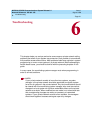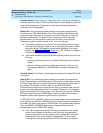
MERLIN LEGEND Communications System Release 6.1
Network Reference
555-661-150
Issue 1
August 1998
Troubleshooting
Page 6-5Call to a Non-Local Extension: Unexpected Busy Tone
6
Call to a Non-Local
Extension: Unexpected Busy Tone 6
This topic discusses unexpected busy tones that may be caused by system
features. It applies not only to regular calls from one private network extension to
another but also to remote access calls that are routed among private network
systems. “Call to Non-Local Extension: Silence or Fast Busy Tone” on page 6
outlines possible causes for a busy tone that relate either to system programming
of facilities or to call routing.
As a first step, the caller should try using Callback. All available local routes for
the call may be busy, and Automatic or Selective Callback allows the call to queue
for the next available tandem trunk assigned to the Route 1 pool.
If a user is having trouble with the Callback feature, see “Callback Does Not Work”
on page 20.
If the wait time for an available local trunk is unacceptable, you may be able to
change the local extension or barrier code FRL and/or route FRLs for the UDP
pattern in order to make more routes available for the call.
If you want to make changes in FRLs for routes, speak with the coordinating
system manager for your private network and consult the following resources:
■ “How Facility Restrictions Levels Work in a Network” on page 9 discusses
FRL planning in detail.
■ To change a UDP route FRL, see “Uniform Dial Plan Routing” on page 25
or “UDP Routing” in Chapter 4 of
System Programming.
■ To change the extension FRL, see
System Programming,
Chapter 3,
“Common Administrative Procedures.”
■ To change the FRL assigned to a remote access barrier code, see “Remote
Access” in
System Programming
, Chapter 4. Follow the guidelines in
“Remote Access Default Class-of-Restriction Settings” on page 6
.
SECURITYlALERT:
!
FRLs, applied to ARS and UDP routes, default class-of-restrictions (COR)
for all tie and/or all non-tie tandem trunks, extensions, and remote access
barrier codes are particularly important for maintaining security in a private
network. Before changing FRLs in your system, check with the coordinating
system manager, who should understand the security implications for your
local system and for the private network as a whole.
Changing local FRLs may not work simply because the problem is not on the local
system. In this case, see “Call to Non-Local Extension: Silence or Fast Busy
Tone” on page 6.


















